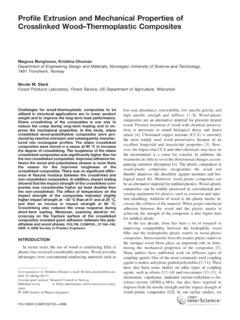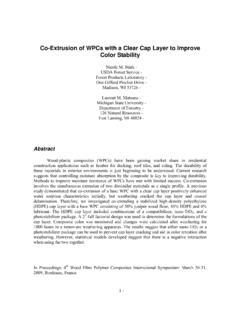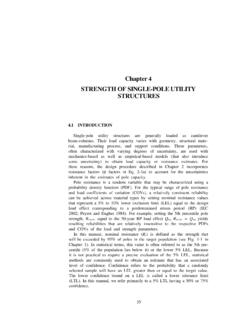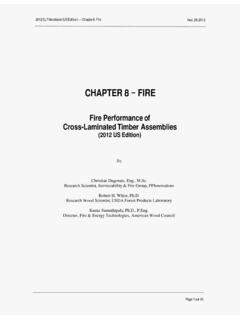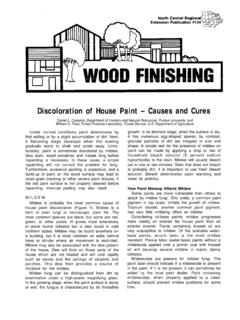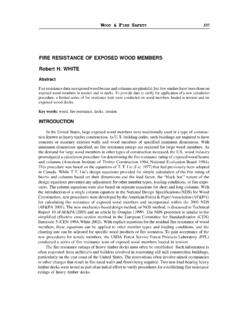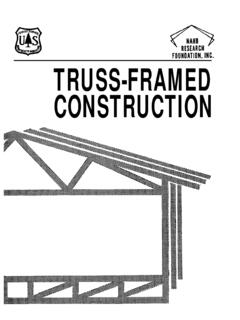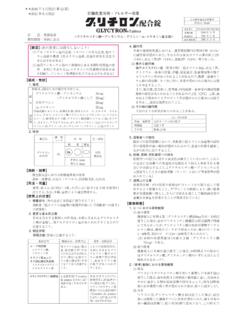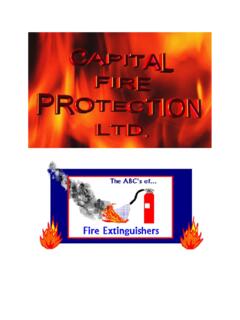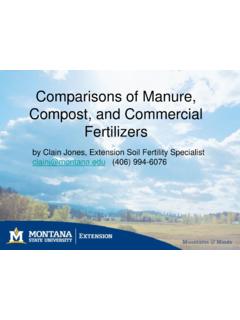Transcription of Fire Performance of Wood: Test Methods and Fire Retardant ...
1 FIRE Performance OF WOOD: TEST METHODSAND FIRE Retardant TREATMENTSM itchell S. SweetFire Safety of Wood Products, USDA Forest ServiceForest Products Laboratory1 One Gifford Pinchot DriveMadison, WI 53705-2398 AbstractThis report describes the fire Performance characteristics of wood and woodproducts, along with test Methods for evaluating the fire properties of thesematerials. Wood treated with fire retardants may provide a code-approvedalternative to noncombustible materials.
2 Fire Performance and problemsassociated with thermal degradation are discussed in terms of the mechanisms offire : Lewin, Menachem, ed. Recent advances in flame retardancy of polymericmaterials. Proceedings of the 4th annual BCC conference on flameretadancy; 1993 May 18 20; Stamford, CT. Norwalk, CT: BusinessCommunications Co. Inc.: [1993]: Forest Products Laboratory is maintained in cooperation with the Universityof Wisconsin. This article was written and prepared by Governmentemployees on official time, and it is therefore in the public domain and not subjectto 1991 in the United States, approximately 3,800 people died as a result of fire instructures, compared to 7,600 deaths in 1972 (Karter, 1992; NFPA, 1973).
3 Propertyloss to structural fires amounted to over $ billion in 1991, an increase from $ in 1972. In the past 20 years, fatalities caused by fires have been reduced by50%, but even when adjusted for inflation, property losses have increased by 25%.It is generally recognized that the combustible contents of buildings often initiatefires and are usually responsible for fire-related deaths. Nevertheless, buildingcodes place considerable emphasis on wood and wood products, which are usedextensively for structural and interior components of buildings.
4 This reportdescribes the fire Performance characteristics of wood, Methods for evaluatingfire properties, and fire Performance of fire- Retardant treated Performance of WoodIgnitionWood, like other cellulosic materials, undergoes thermal degradation at elevatedtemperatures. This phenomenon, pyrolysis, follows a low-temperature pathway(below 300 C (570 F)) and a high-temperature pathway (above 300 C) (Shafizadeh,1984). At low temperatures, the pyrolysis of wood favors the formation of char andevolution of noncombustible gases such as H2O and CO2.
5 At high temperatures,tars and combustible gases are produced. These combustible volatiles combinewith oxygen to burn . In the presence of a pilot flame, the volatiles can ignite witha minimum rate of heating of 13 kW/m2 ( Btu/ft2 s). When no pilot flame ispresent, spontaneous ignition can occur, although roughly twice the heat flux isrequired about 25 kW/m2 ( Btu/ft2 s) (Lawson and Simms, 1952). The surfacetemperature for the rapid spontaneous ignition of wood has been determined to bebetween 330 and 600 C (626 and 1,112 F) (Beall and Eickner, 1970; Kanury, 1972).
6 Forest Products Laboratory (FPL) is currently using ASTM Test Method E1321-90(ASTM, 1990) for measure-merit of both ignition and flame spread. The heat flux ofthe radiant panel is adjusted until the minimum flux required to ignite thespecimen, using piloted ignition, is ResistanceWood has excellent natural fire resistance as a result of low thermal conductivityand the fact that char is formed as wood burns. This layer of char preventsfurther fire penetration, while the wood beneath the char retains most of itsoriginal strength properties.
7 In the standard fire conditions for ASTM E119(ASTM, 1988), a thick piece of wood is exposed to fire conditions between 815 C and1,038 C (1,500 F and 1,900 F). The outermost layer of wood is charred, but deeperinto the wood, the temperature drops. The active char area is found to correspondto the depth at which the wood temperature reaches 290 C (550 F). Beyond thatdepth, the temperature drops further; at the depth at which the temperature fallsto 175 C (347 F), the wood is no longer darkened.
8 At a depth of 13 mm ( in.) fromthe active char zone, the wood is only 105 C (220 F). Table I contains some typical37values of char rates for various softwoods and hardwoods under ASTM E119testing I Average char rates and flame spreadindices for selected wood speciesSpeciesChar rate (mm/h)aFSIbSoftwoodsWestern hemlockDouglas-firEngelmann spruceWestern redcedarSouthern pineRedwoodHardwoodsHard mapleYellow-poplarRed oakBasswood 374949464245365560-7570-100 69-73130-19570104170-185100130-140a 1 mm.
9 Data from White and Nordheim(1992).bFlame spread index (UL, 1971).Flame SpreadFlame spread is the propagation of a flame along the surface of wood. ASTM TestMethod E84 (ASTM, 1991) involves exposure of a specimen with dimensions of (24 ft) by m (20 in. ) to a gas burner. In the past, red oak was taken to be thestandard for the test and was arbitrarily assigned a value of 100. Red oak was usedbecause of its availability and fairly uniform properties. Today, red oak is still usedas a calibration material for the test method, with a flame spread index (FSI) near100.
10 The FSIs are now calculated from the time necessary for the flame front toadvance the length of the test specimen. In general, untreated natural woodproducts (25 mm (1 in.) lumber) have FSIs of 90-160; a few species have flameindices below 75 (western hemlock, western redcedar, redwood) and others havevalues above 170 (yellow- poplar) (Table I).Building Codes have defined classifications for flame spread from the FSI of amaterial. Class A or I materials have indices of 0-25; Class B or II, 26-75; andClass C or III, Release RateThe rate of heat release (HRR) can be determined by several approaches,including the sensible heat and oxygen consumption Methods .
